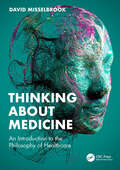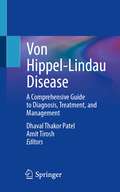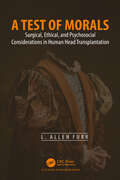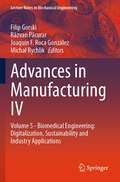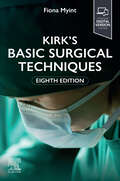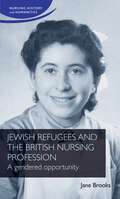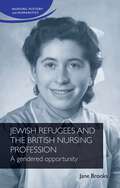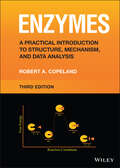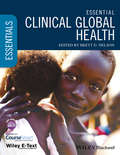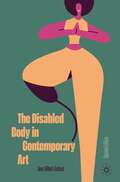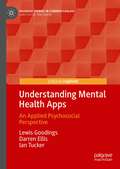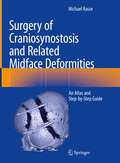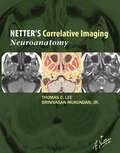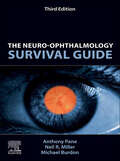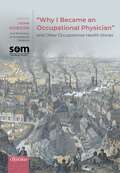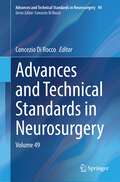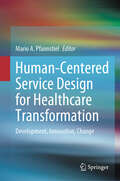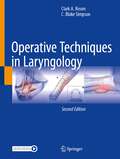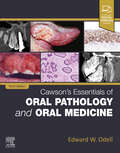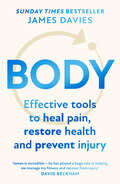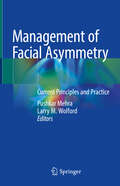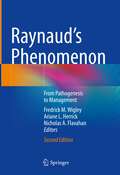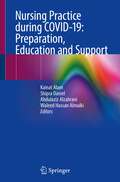- Table View
- List View
Thinking About Medicine: An Introduction to the Philosophy of Healthcare
by David MisselbrookThis introduction to the philosophy of medicine surveys the landscape of western philosophy as it pertains to healthcare in an accessible way. Written by a doctor for doctors and other health professionals, framing the 'toolbox' of philosophy within the community of medicine, it encourages examination of the implicit assumptions made in the construction of medical knowledge and practice.Taking the reader step by step through the concepts that underpin modern philosophy, they will be challenged to reflect upon the premises within clinical practice which might benefit from scrutiny and challenge, including the nature of scientific knowledge, the limits of our biomedical model, the cultural and relational context, and the failure to recognise or manage adequately the fact/value distinction in medicine and healthcare.The book is an ideal textbook for students of medicine and medical philosophy and will also be of interest to bioethicists, medical sociologists, clinical commissioners and to practicing clinicians in medicine and the allied health professions seeking to improve their understanding of philosophy and ethics and sharpen their critical thinking skills.
Von Hippel-Lindau Disease: A Comprehensive Guide to Diagnosis, Treatment, and Management
by Dhaval Thakor Patel Amit TiroshVon Hippel-Lindau (VHL) disease is an inherited disorder characterized by the abnormal growth of both benign and cancerous tumors and cysts in many parts of the body. Considering the number of manifestations of the VHL disease, screening and management is complex and requires a multidisciplinary effort as well as an understanding of the interplay between all the manifestations. This book is one of the first to provide fundamental knowledge about VHL and the know-how on the various manifestations of this complex syndrome. Various aspects of VHL are reflected in this book's table of contents, written by the leading experts in each field discussed. Comprehensive and easy-to-use, this book offers a detailed and comprehensive analysis of the manifestations and management of patients with VHL and serves as the definitive book on the management of patients with VHL for surgical oncologists, endocrinologists, urologists, neurosurgeons, ophthalmologist, radiologists, and all primary care physicians.
A Test of Morals: Surgical, Ethical, and Psychosocial Considerations in Human Head Transplantation
by L. Allen FurrWhile transplanting human heads is not a new concept, the idea has largely been relegated to religious lore or as a plot device in science fiction. But now, a surgical plan to perform the complex procedure exists, and though most physicians question head transplantation’s medical veracity, bioethicists have challenged the surgery on moral grounds. A Test of Morals compiles and examines the ethical questions that dog those who advocate for conducting this most radical of medical proposals in order to determine if society should move forward and allow head transplantation to occur. Current bioethical principles stand in opposition to head transplantation, causing a conflict of values rarely seen in medicine.
A Test of Morals: Surgical, Ethical, and Psychosocial Considerations in Human Head Transplantation
by L. Allen FurrWhile transplanting human heads is not a new concept, the idea has largely been relegated to religious lore or as a plot device in science fiction. But now, a surgical plan to perform the complex procedure exists, and though most physicians question head transplantation’s medical veracity, bioethicists have challenged the surgery on moral grounds. A Test of Morals compiles and examines the ethical questions that dog those who advocate for conducting this most radical of medical proposals in order to determine if society should move forward and allow head transplantation to occur. Current bioethical principles stand in opposition to head transplantation, causing a conflict of values rarely seen in medicine.
Advances in Manufacturing IV: Volume 5 - Biomedical Engineering: Digitalization, Sustainability and Industry Applications (Lecture Notes in Mechanical Engineering)
by Filip Gorski Răzvan Păcurar Joaquín F. Roca González Michał RychlikThe book covers timely topics in digital healthcare and personalized medical products. It delves into the use of digital technologies like image processing, CAD, AI, and 3D printing in healthcare, emphasizing their role in customizing treatment and manufacturing medical products. Based on peer-reviewed contributions to the 8th International International Scientific-Technical Conference (MANUFACTURING 2024) held on May 14-16, 2024, in Poznan, Poland, the chapters reports on achievements from interdisciplinary collaborations between engineers, doctors, and the medical industry. All in all, this book offers a timely guide for researchers and professionals in medical design, manufacturing, and biomedical engineering, and a bridge fostering communication and collaborations between different stakeholders working on enhancing health interventions through technology.
Basic Surgical Techniques: Kirk's Basic Surgical Techniques - E-Book
by Fiona MyintKirk's Basic Surgical Techniques provides a foundation on surgical technique to ensure operational success. Covering the basic techniques that every surgeon needs to know, across all specialties and subspecialties. Comprehenisvely reviewing the full range of surgical skills this book provides guidance on key operative skills, managing different situations, and handling the patient - all with clear ‘how-to’ explanations of each technique. This eighth edition has been thoroughly revised by Fiona Myint, a Consultant Vascular Surgeon at the Royal Free Hospital and Professor of Surgical Education at UCL. It maintains the clear, instructive style of its highly respected original author Professor R. M. Kirk.Provides guidance on the full range of surgical techniques and skills required by all trainee surgeonsConcentrates on the main principles behind the use of surgical techniquesKey points boxes provide hints and tips to reinforce the main aspects of each techniqueUpdated chapters throughoutA synopsis of commonly used surgical dressingsGuidance on how to handle the teamAn enhanced eBook version is included with purchase. The eBook allows you to access all the text, gures and references, with the ability to search, customise your content, make notes and highlights, and have content read aloud
Jewish refugees and the British nursing profession: A gendered opportunity (Nursing History and Humanities)
by Jane BrooksThis book follows the lives of female Jewish refugees who fled Nazi persecution and became nurses. Nursing was nominally a profession but with its poor pay and harsh discipline, it was unpopular with British women. In the years preceding the Second World War, hospitals in Britain suffered chronic nurse staffing crises. As the country faced inevitable war, the Government and the profession’s elite courted refugees as an antidote to the shortages, but many hospitals refused to employ Continental Jews.The book explores the changes in the refugees’ status and lives from the war years to the foundation of the National Health Service and to the latter decades of the twentieth century. It places the refugees at the forefront of manoeuvres in nursing practice, education and research at a time of social upheaval and alterations in the position of women.
Jewish refugees and the British nursing profession: A gendered opportunity (Nursing History and Humanities)
by Jane BrooksThis book follows the lives of female Jewish refugees who fled Nazi persecution and became nurses. Nursing was nominally a profession but with its poor pay and harsh discipline, it was unpopular with British women. In the years preceding the Second World War, hospitals in Britain suffered chronic nurse staffing crises. As the country faced inevitable war, the Government and the profession’s elite courted refugees as an antidote to the shortages, but many hospitals refused to employ Continental Jews.The book explores the changes in the refugees’ status and lives from the war years to the foundation of the National Health Service and to the latter decades of the twentieth century. It places the refugees at the forefront of manoeuvres in nursing practice, education and research at a time of social upheaval and alterations in the position of women.
Enzymes: A Practical Introduction to Structure, Mechanism, and Data Analysis
by Robert A. CopelandENZYMES A complete and approachable introduction to the study of enzymes, from theory to practice Enzymes catalyze the bulk of important biological processes, both metabolic and biochemical. They are specialized proteins whose function is determined by their structure, understanding which is therefore a key focus of biological, pharmacological, and agrarian research, among many others. A thorough knowledge of enzyme structure, pathways, and mechanisms is a fundamental building block of the life sciences and all others connected to them. Enzymes offers a detailed introduction to this critical subject. It analyzes enzyme proteins at the structural level and details the mechanisms by which they perform their catalyzing functions. The book’s in-depth engagement with primary literature and up-to-date research allows it to continuously deploy illustrative examples and connect readers with further research on key subjects. Fully updated after decades as the standard text, this book unlocks a thriving field of biological and biochemical research. Readers of the third edition of Enzymes will also find: Expanded chapters on steady-state and transient-state enzyme kinetics, structural components of enzymes, and more New chapters on enzyme regulation, enzyme-macromolecule interactions, enzyme evolution, and enzymes in human health Key Learning Points at the beginning of each chapter to assist students and instructors Enzymes promises to continue as the standard reference on this subject for practitioners of the life sciences and related fields in both academia and industry.
Essential Clinical Global Health: Includes Wiley E-text (Essentials)
by Brett D. NelsonEssential Clinical Global Health is a brand-new, pioneering, and evidence-based textbook that provides a clinical overview of the increasingly prominent specialty of global health. Originally developed from a course at Harvard Medical School, and now with contributions from nearly 100 world-renowned global health experts from across the globe, this textbook presents vital information required of students, trainees, and clinicians during their international experiences and training. Essential Clinical Global Health introduces readers to the up-to-date knowledge, skills, and approaches needed for productive and rewarding global health experiences. It provides essential clinical information on the diagnosis, management, and prevention of the leading causes of morbidity and mortality in low- and middle-income countries. The textbook also includes practical guidance on topics such as health systems, population-based approaches, cultural awareness and sensitivity, travel preparedness and safety, and career development in global health. With key learning objectives in each chapter, practical clinical advice, setting-appropriate guidelines, personal field experiences from student and clinician contributors, Essential Clinical Global Health is the first global health textbook with a clinical focus for healthcare students, trainees, and providers.A companion website at www.wileyessential.com/globalhealth features self-assessment questions and videos.
The Disabled Body in Contemporary Art
by Ann Millett-GallantThe second edition offers an essential update to the foundational first edition, The Disabled Body in Contemporary Art. Featuring updated chapters and case studies, this second edition will not only expand on the first edition but will bring a new focus to contemporary disabled artists and their embodied, multimedia work.
Understanding Mental Health Apps: An Applied Psychosocial Perspective (Palgrave Studies in Cyberpsychology)
by Lewis Goodings Darren Ellis Ian TuckerThis is the first book to look exclusively from at the use of MHapps from an applied psychosocial perspective. Much of the academic literature on MHapps in psychology focuses on the clinical efficacy of using apps (e.g., depression reduction as result of using a certain app) and will typically report on the use of randomised controlled trials (or a similar method) to illustrate the use of apps as a tool for improving a psychological condition. Therefore, the main benefit of this book is that it recognises the impact of apps from a social perspective and will aim to show how everyday forms of distress are embedded in the use of these apps and the broader set of relations that constitute people’s everyday lives. The content of this book will identify how an applied social perspective can offer insight into the power of apps to shape our sense of ourselves and of others. This book will be of use to educators and students in psychology, sociology, health studies, media studies andcultural studies.
Herz-Kreislauf (Springer-Lehrbuch)
by Thomas F. Lüscher Ulf LandmesserDer Blick aufs GanzeEs ist immer wieder dasselbe: Wenn im klinischen Abschnitt endlich die spannenden Krankheitsbilder kommen, sind Anatomie und Physiologie längst vergessen. Mühsam muss man alles wiederholen, um zu verstehen, worum es bei der Erkrankung geht.Lernen Sie ein Organsystem doch einfach „am Stück“: von der Anatomie über die Physiologie bis zur Diagnostik und Therapie von Erkrankungen. Dieses Buch ist ideal für das Lernen im Modul, hier verstehen Sie das Organsystem im Zusammenhang. Die Erkrankungen des Herz-Kreislauf-Systems werden systematisch abgehandelt - endlich genügt ein einziges Buch, um den ganzen Themenblock durchzuarbeiten. Und dabei helfen Ihnen: Praktische Anleitungen für Diagnostik und TherapieZahlreiche diagnostische BilderNeueste Erkenntnisse und TherapieverfahrenMerksätze, Tabellen und Übersichten mit den wichtigsten FaktenWegen seiner Praxisnähe ist dieser Band sowohl für Medizinstudenten als auch für Ärzte in der kardiologischen Aus- und Weiterbildung bestens geeignet.Für die dritte Auflage wurde das Buch sorgfältig aktualisiert und um zwei neue Kapitel zur pulmonalen Hypertonie sowie Erkrankungen des venösen Systems ergänzt. So bleiben Sie auch mit der dritten Auflage am Puls der Zeit in der Kardiologie!
Surgery of Craniosynostosis and Related Midface Deformities: An Atlas and Step-by-Step Guide
by Michael RasseThis atlas offers a comprehensive overview of osteotomies performed on the calvaria and midface for both syndromic and non-syndromic craniosynostosis.It presents a systematic approach, beginning with calvarial osteotomies. The author introduces a general type of osteotomy that can be applied for total vault remodeling in cases of total synostosis. These osteotomies can also be modified and used in single or combined synostoses. To shape the calvaria, the book describes the use of metal plates as a scaphold. These plates can be prebent on 3-D models and used to fix the segments after osteotomies. Following that, resorbable osteosynthesis is performed, and the metal plates are subsequently removed. This unique approach, combined with standardized osteotomies, ensures highly predictable results that are not currently described in textbooks. The book includes clinical examples for each type of synostosis and various combinations, including two-stage procedures and combinations with distraction techniques. These examples provide surgeons with a solid foundation for addressing different cases. In the chapter on midface osteotomies, the book explains the access and technique for performing the LeFort-III osteotomy using cadaver and clinical figures. It covers all types of LeFort-I to III osteotomies and their combinations through clinical cases. The book illustrates the osteotomies, osteosynthesis, distraction techniques, and combinations using clinical examples. Additionally, the book demonstrates the method of computer planning, the fabrication of osteotomy guides, and the use of preformed plates to define the position of the segments.The book's primary objective is to serve as a surgical guide that transcends the boundaries of medical specialties. Given that this type of surgery is often performed by different specialists across institutions and countries, the book aims to facilitate cooperation and provide a practical application tool for surgeons beyond offering a clinical overview.
Netter’s Correlative Imaging: with NetterReference.com Access (Netter Clinical Science)
by Thomas C. Lee Srinivasan MukundanInterpret the complexities of neuroanatomy like never before with the unparalleled coverage and expert guidance from Drs. Srinivasan Mukundan and Thomas C. Lee in this outstanding volume of the Netter’s Correlative Imaging series. Beautiful and instructive Netter paintings and illustrated cross-sections created in the Netter style are presented side by side high-quality patient images and key anatomic descriptions to help you envision and review intricate neuroanatomy. Consult this title on your favorite e-reader, conduct rapid searches, and adjust font sizes for optimal readability. View the brain, spinal cord, and cranial nerves, as well as head and neck anatomy through modern imaging techniques in a variety of planes, complemented with a detailed illustration of each slice done in the instructional and aesthetic Netter style. Find anatomical landmarks quickly and easily through comprehensive labeling and concise text highlighting key points related to the illustration and image pairings. Correlate patient data to idealized normal anatomy, always in the same view with the same labeling system.
The Neuro-Ophthalmology Survival Guide: The Neuro-Ophthalmology Survival Guide E-Book
by Anthony Pane Neil R. Miller Michael BurdonThis book is a practical, symptom-based, 'how-to' guide to neuro-ophthalmology for all trainee and practising ophthalmologists, optometrists, and physicians whose practice includes patients with eye or brain issues. Each chapter focusses on a specific clinical symptom and includes an introduction to the clinical assessment of a symptom; an examination checklist; a management flowchart to be followed; clinical diagnostic criteria checklists; and further information on the diseases that can cause the symptom with a brief discussion of appropriate management.A practical and accessible handbook for the ophthalmologist, optometrist, or other physician without a specialist interest in neuro-ophthalmology.Simplifies a subject that is often a cause of litigation against practising ophthalmologists and exam failure for trainees and residents.Aids diagnosis in a field in which mistakes may lead to serious consequences, e.g. patients with brain tumours presenting with blurred or double vision.Uniquely guides the reader from presenting symptoms, through a series of simple but safe flowcharts and checklists, to the necessary tests, diagnosis, and timely treatment.The first chapter presents 20 'golden rules' to keep you and your patients out of trouble.Updates throughout the text include recent advances in diagnosis and treatment for conditions with improved pathophysiological insights; genetic aspects of several conditions and their impact on management; imaging and laboratory tests available for diagnosis of disorders.New self-assessment quizzes to consolidate everyday clinical skills or for exam preparation.More than 60 online videos demonstrate examination techniques as well as abnormal eye movements, eyelid problems and pupil abnormalities.
"Why I Became an Occupational Physician" and Other Occupational Health Stories
by John Hobson"Why I Became an Occupational Physician" and Other Occupational Health Stories brings together an edited collection of the short articles published in the journal Occupational Medicine between 2002 and 2018. The articles originally appeared as 'fillers', commissioned to literally 'fill' the blank spaces at the end of the main scientific papers, but they soon became a feature in their own right. Written by doctors working in occupational medicine and health, the fillers began as a series of pieces exploring the varied and often surprising reasons why the individuals chose to pursue this unique speciality, whether it was a natural career move, triggered by a specific event, or stumbled upon by chance. Over time the articles became much broader in their scope and the journal began to attract pieces from some brilliant writers: Mike Gibson, John Challenor, Nerys Williams, and of course the superlative Anthony Seaton, amongst many others. Each article offers something different: a peek into history, a humorous adventure, a quiet musing, or a thought-provoking observation, but all are tied together under the umbrella of occupational medicine, a speciality that is often little known or understood in the wider world of medicine. This book brings together over 15 years' worth of fascinating and diverse articles into one volume for the first time, giving a rare insight into the world of the occupational physician.
Advances and Technical Standards in Neurosurgery: Volume 49 (Advances and Technical Standards in Neurosurgery #49)
by Concezio Di RoccoThe book offers the update on several basic and clinical problems in neurosurgery compiled by internationally recognized experts. The main topics covered are cerebral tumors, epilepsy and vascular malformations, congenital and acquired spine anomalies.The first chapter is devoted to the genetic of the Moya-Moya disease, a cerebral vascular disease quite common in Asia that is not yet sufficiently known. The second chapter is devoted to the current application of VR/AR (virtual reality/augmented reality) to pediatric neurosurgery. The next four chapters discuss the management of spine diseases, respectively the tethered cord syndrome , the severe forms of spondylolisthesis, the role of perioperative checklists, and the long-term outcomes of myelomeningocele. Two chapters deal with the surgical aspects of the management of intraventricular tumors. Cerebral tumors, namely malignant gliomas and jugular foramen tumors are the subject of the remaining chapters.Approaching the issue of technical standards in the everyday clinical practice of neurosurgery, this book of great interest for neurosurgeons, neuroradiologists, vascular and plastic surgeons.
Human-Centered Service Design for Healthcare Transformation: Development, Innovation, Change
by Mario A. PfannstielThis book explores the use of human-centered service design. Through a variety of case studies and best practices, it highlights ways to systematically improve the provision of healthcare services to different target and age groups in order to understand customer expectations and needs. The book also offers new insights into the dyadic relationship between service provider and customer, each of which has their own set of goals, purposes, and benefits and must cope with a scarcity of resources and opportunities to optimize and design. Written by recognized experts, scholars, and practitioners, this book demonstrates how, where, and when to successfully apply human-centered service design at multiple levels, including corporate, departmental, and product/service. Value-added services are not only assessed in terms of their effectiveness, efficiency, and productivity, but also bearing in mind human emotions, interactions, and communication techniques as an importantpart of service provision. Accordingly, the book will appeal to scholars and practitioners in the hospital and healthcare sector, and to anyone interested in organizational development, service business model innovation, customer involvement and perceptions, and the service experience.
Operative Techniques in Laryngology
by Clark A. Rosen C. Blake SimpsonThis book provides the laryngeal surgeon with essential background information on laryngological disorders, step-by-step surgical information, and key pearls and pitfalls for laryngeal surgery. The field of laryngeal surgery for voice, swallowing, and airway pathologic conditions has dramatically changed over the last 20 years, and the impetus for this book was to reflect these major paradigm shifts and bring together in one place the essential information on the rapidly growing and changing field of laryngeal surgery. Introductory chapters provide a foundation for the diagnosis and preoperative management of laryngeal pathological conditions. These are followed by the procedural chapters, which encompass a wide range of laryngeal procedures. They have been organized around the broad categories of phonomicrosurgery, awake laryngeal surgery, laryngeal framework surgery, and open airway reconstruction. Each procedural chapter is brief, consisting of five to ten pages, and presents progressive instructions for different laryngeal surgical approaches. The individual steps of the procedure are clearly demonstrated through a series of high-quality intraoperative photos and schematic illustrations. In addition, key aspects of certain procedures are accompanied by a short video. All pertinent information regarding equipment, instrumentation, post-operative care, and possible complications associated with the surgical approach is summarized in bullet format at the end of each chapter. Most of the laryngeal procedures feature an expert commentator who has provided unique insights on important steps and different approaches to the described surgical procedure to provide the reader a variety of perspectives. Operative Techniques in Laryngology is aimed at general otolaryngologists, residents, laryngology fellows, and laryngologists. The emergence and growth of laryngology as a sub-specialty of otolaryngology has established this field as an important partof general otolaryngology training.
Cawson's Essentials of Oral Pathology and Oral Medicine - E-Book: Cawson's Essentials of Oral Pathology and Oral Medicine - E-Book
by Edward W OdellThe tenth edition of this core textbook will prepare the reader to diagnose and treat many different diseases and disorders that they may not have encountered in person before. The text integrates oral medicine, pathology, and surgical and drug treatment, allowing the reader to apply diagnostic algorithms and develop the key understanding they will need to apply theory to clinical practice. Originally published in 1962, Cawson's Essentials of Oral Pathology and Oral Medicine continues to offer its trademark easy-to-read style, a world-class collection of photographs showing oral conditions, and the latest evidence and guidelines to support safe clinical practice.Thoroughly updated to include new guidelines, oral diseases and treatments including the new WHO Classification of Tumours 2022 terminologyFriendly, accessible writing style provides ready access to essential informationFlow charts to guide the reader thorough the process of differential diagnosis for a range of conditionsEvidenced-based throughout to help facilitate safe clinical practiceSelf-assessment to support understanding and problem solvingSummary charts to aid learning and revisionNew chapters on pathological and diagnostic aspects of cosmetic proceduresNew section on respiratory disease including COVID-19; other new diseases such as MPox includedChapter listing adverse eventsInformation on genetic causes of diseases and tumours, along with novel treatmentsInformation on periodontal diseases completely revised and updated in the light of recent researchNew and extra images included throughout
Body
by null James DaviesThe Sunday Times bestseller with all the strategies you need to prevent pain and fuel your body to its fullest health potential. ‘James is incredible – he has played a huge role in helping me manage my fitness and recover from injury over the years’ David Beckham Simple techniques and strategies to HEAL From stress and anxiety, to everyday wear and tear and injury, life takes its toll on our bodies. Now, internationally renowned osteopath James Davies can help you heal your body. RESET With tips and tricks to help recognise, manage, and treat everyday aches and pains, this book will reset your approach to understanding your body. James presents a revolutionary blueprint for holistic body wellbeing. RESTORE Improve your wellbeing with exercises expertly designed to optimise your body. Enhance your health and mobility by understanding common conditions from arthritis and muscle strains, to IBS and stress, and empower yourself with the knowledge you need to achieve full-body health. BODY was number 9 in the Sunday Times Bestseller Chart w/b 12th September 2022
Management of Facial Asymmetry: Current Principles and Practice
by Pushkar Mehra Larry M. WolfordThis book provides clear practical guidance on the contemporary management of patients with asymmetry of facial structures. Patient evaluation and diagnosis are first fully described. Key radiological and orthodontic considerations are identified and the role of virtual surgical planning is explained. Individual chapters then focus on management principles in patients with craniosynostosis, hemifacial microsomia, condylar hyperactivity, and temporomandibular ankylosis/degenerative disease. The remainder of the book is devoted to the state of the art in treatment procedures, covering distraction osteogenesis, the use of facial implants, diverse soft tissue procedures, and jaw and other osteotomies. The text is augmented by informative clinical cases, easy-to-follow tables, photographs, and illustrations. The authors are highly experienced clinicians well recognized for their expertise in this area. The book will be ideal for all clinicians involved in the care of patients afflicted by facial asymmetry and will in particular be an indispensable tool for those who evaluate and treat the condition in day-to-day practice.
Raynaud’s Phenomenon: From Pathogenesis to Management
by Fredrick M. Wigley Ariane L. Herrick Nicholas A. FlavahanThis book comprehensively reviews the understanding of a disorder that continues to challenge primary care clinicians and specialists. Raynaud’s phenomenon is an inappropriate and exaggerated response of the digital and cutaneous circulation to cold environmental temperatures. It is common, often causing significant morbidity and it is a major challenge for physicians at every level and specialty. A comprehensive review of Raynaud’s is now timely because of the incredible progress in understanding the molecular mechanisms of the normal regulation of cutaneous blood flow and how disease can disrupt the function of these specialized vessels. Likewise, the clinical implications of Raynaud’s phenomenon are better appreciated with studies defining its prevalence, the associated diseases, and new treatment approaches for patients suffering from it. The nomenclature used to classify cases has changed over the years and is important to understand these terms both for clinical care andresearch. This fully updated second edition comprehensively discusses various causes of Raynaud’s phenomenon including childhood Raynaud’s phenomenon, Raynaud’s phenomenon secondary to connective tissue disease, occupational causes, and a variety of other associated disorders. Careful consideration is given to the diagnosis of Raynaud’s phenomenon with state of the art discussion of nailfold capillary examination, non-invasive imaging, angiography, and appropriate serological testing. The concept that Raynaud’s phenomenon is associated with systemic disease or can be the manifestation of a systemic vasospastic disorder is also presented. In addition to reviewing both non-drug and drug therapy for patients with Raynaud’s phenomenon, this volume provides a practical approach in specific clinical situations by presenting problematic cases and the authors’ expert opinions on therapy. It also discusses mechanisms contributing to the vascular dysfunctionof primary Raynaud’s phenomenon and the vascular disease of secondary Raynaud’s phenomenon. Engaging readers with case vignettes and a plethora of visual aids, Raynaud’s Phenomenon: From Pathogenesis to Management is a state-of-the-art, authoritative reference and invaluable contribution to the literature that will be of interest to adult and pediatric physicians, rheumatologists, and clinical and basic researchers.
Nursing Practice during COVID-19: Preparation, Education and Support
by Kainat Alam Shipra Daniel Abdulaziz Alzahrani Waleed Hassan AlmalkiThis book highlights the progresses achieved in the role of nurses in the hospital, critical care unit, community field, hospital, and at home for patient care management in SARS-CoV-2 (COVID-19), especially in the South Asia and the Middle East. Nurses and allied health care professionals play a significant role in preventing and treating the infectious disease pandemic and epidemic that is COVID-19 and, on the front lines of treatment, they suffer an inescapable health risk due to the fact that they must live with, encounter, and accept the hazard of dealing with developing respiratory illnesses. Nurses also endure significant stress, burden, and mental health concerns as a result of worldwide respiratory epidemics. Because of this, nurses require ongoing assistance and training in order to increase their crisis preparation and efficacy while also coping with psychological issues and ensuring their own well-being. This book reflects the experience of Indianand Saudian nurses, develops on COVID-19 stress and challenges and informs on the technologies employed. Nurses' experiences caring for patients with COVID-19 around the world are scarcely documented. The research that has been done so far have mostly focused on the physical and psychological effects of stress. This expands on the role of nurse managers and hospital administration with key stakeholders emphasizing the need of providing support for nurses in their role, especially considering that the positive leadership responsibilities of nurse managers are highly regarded by nurses.
